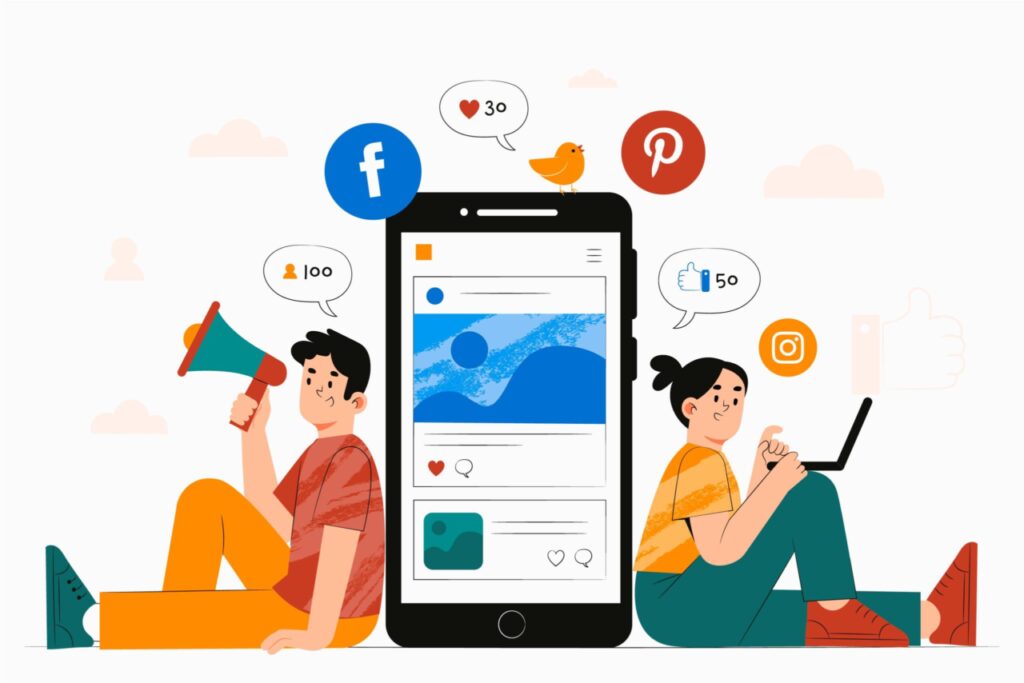Social media marketing is constantly evolving and adapting to the changing needs and preferences of consumers, businesses, and platforms. In order to stay ahead of the curve and achieve your marketing goals, you need to keep up with the latest Social Media Marketing trends and developments.
Social media marketing in 2025 is undergoing a seismic shift. With over 5 billion users globally and platforms evolving at lightning speed, brands must adapt to stay relevant. From AI-powered content creation to immersive AR experiences, this year’s trends are redefining how businesses engage, convert, and build communities online.
- List of Latest Social Media Marketing Trends and Developments
- 1. AI-Powered Content Creation Becomes Mainstream
- 2. Short-Form Video Dominance
- 3. Social Commerce Takes Center Stage
- 4. Hyper-Personalization Through AI
- 5. Rise of Micro and Nano Influencers
- 6. Platform-Specific Strategies
- 7. Authenticity Over Perfection
- 8. Social Media as a Search Engine
- 9. Creator Economy Expansion
- 10. AR and VR Integration
- 11. Enhanced Analytics and Sentiment Analysis
- 12. Community Building and Engagement
- 13. Ethical and Sustainable Marketing
- 14. Social Audio and Live Content
- 15. AI Chatbots and Customer Support
- 16. Live Streaming and Video Content
- 17. Social Commerce and Shoppable Posts
- 18. User-Generated Content (UGC) and Influencer Marketing
- 19. Social Listening and Sentiment Analysis
- Final Thoughts: Thriving in the 2025 Social Media Marketing Trends
List of Latest Social Media Marketing Trends and Developments

Here are some of the most important ones that you should pay attention to in 2025.
1. AI-Powered Content Creation Becomes Mainstream
Artificial Intelligence is no longer a novelty—it’s the backbone of modern social media marketing. AI tools streamline everything from captions to video scripts, saving time and boosting efficiency. Marketers pair automation with human creativity for more emotional and impactful messaging.
- AI tools like ChatGPT, Jasper, and Copy.ai are used to generate captions, blog snippets, and even visual content.
- Marketers use AI for content scheduling, sentiment analysis, and audience targeting, saving time and boosting efficiency.
- AI-generated memes and videos are outperforming traditional content, with engagement rates up to 60% higher.
Takeaway: Brands must balance automation with authenticity. AI can handle the heavy lifting, but human creativity still drives emotional connection.
2. Short-Form Video Dominance
Short-form video continues to reign supreme across platforms like TikTok, Instagram Reels, and YouTube Shorts. Videos under 60 seconds dominate TikTok, Reels, and Shorts with sky-high engagement rates. Storytelling in the first 3-5 seconds is key to capturing attention and driving conversions.
- TikTok boasts 2.051 billion users, and Instagram Reels sees 17.6 million daily viewing hours.
- Videos under 60 seconds are ideal for capturing attention and driving conversions.
- Brands are repurposing long-form content into bite-sized clips to maximize reach.
Takeaway: Invest in storytelling that hooks viewers within the first 3 seconds. Authentic, raw content often outperforms polished ads.
3. Social Commerce Takes Center Stage
Social media is now a full-fledged shopping destination. In-app purchases and shoppable content make social platforms full-fledged shopping hubs. Live shopping and UGC drive trust, impulse buying, and higher ROI.
- Platforms like TikTok Shop, Instagram Shopping, and Pinterest enable in-app purchases.
- Social commerce is projected to hit $1 trillion globally in 2025.
- Live shopping events and shoppable videos are driving impulse buys and higher conversion rates.
Takeaway: Optimize your product listings for mobile-first experiences. Use influencers and UGC to build trust and drive sales.
4. Hyper-Personalization Through AI
Consumers expect tailored experiences—and AI delivers. AI tailors content to user behavior, resulting in more meaningful interactions. Personalization boosts engagement by up to 40%, making it essential for brand success.
- Dynamic ads adapt to user behavior in real-time.
- AI analyzes demographics, interests, and engagement to deliver personalized content.
- Brands using AI personalization see 40% higher engagement and revenue.
Takeaway: Use AI to segment audiences and deliver content that resonates. Personalization is no longer optional—it’s expected.
5. Rise of Micro and Nano Influencers
Influencer marketing is shifting from celebrity endorsements to niche creators. Smaller influencers bring high authenticity and deeper connections to niche communities. Brands favor long-term collaborations that feel personal and trustworthy.
- Micro-influencers (10k–50k followers) and nano-influencers (<10k) offer higher engagement and authenticity.
- These creators foster tight-knit communities and drive meaningful conversations.
- Brands are forming long-term partnerships rather than one-off campaigns.
Takeaway: Focus on influencers who align with your brand values. Authenticity and trust matter more than follower count.
6. Platform-Specific Strategies
Cross-posting is out. Tailored content is in. Copy-pasting across platforms no longer works; content must be tailored per channel. Understanding platform culture ensures better reach and engagement.
- Each platform has unique algorithms, audiences, and content formats.
- TikTok favors trends and humor, while LinkedIn rewards thought leadership and professional insights.
- Brands are customizing tone, visuals, and messaging per platform.
Takeaway: Understand platform culture. Create content that feels native to each space.
7. Authenticity Over Perfection
Consumers crave realness. Raw, relatable posts outperform overly polished content in building audience trust. Behind-the-scenes and quirky storytelling deepen emotional connection.
- Raw, behind-the-scenes content outperforms polished ads.
- Brands like Duolingo and Scrub Daddy thrive on quirky, unfiltered posts.
- Relatable storytelling builds emotional connection and loyalty.
Takeaway: Ditch the corporate gloss. Show your brand’s personality and imperfections.
8. Social Media as a Search Engine
Platforms like TikTok and Instagram are becoming discovery tools. Gen Z increasingly turns to platforms like TikTok for product discovery and tutorials. Optimizing captions, hashtags, and visuals boosts content discoverability.
- Gen Z prefers searching on social media over Google.
- Users look for product reviews, tutorials, and recommendations directly on platforms.
- SEO for social now includes keywords in captions, hashtags, and on-screen text.
Takeaway: Optimize your content for searchability. Think like a user and answer their questions visually.
9. Creator Economy Expansion
Creators are more than influencers—they’re collaborators. Creators co-develop campaigns and products, adding authenticity to brand narratives. Their content feels native and drives organic growth beyond paid promotions.
- B2B creators on LinkedIn share insights and drive engagement.
- UGC creators help brands produce organic-looking content.
- Brands are co-creating products and campaigns with creators.
Takeaway: Treat creators as strategic partners. Their voice can amplify your brand in authentic ways.
10. AR and VR Integration
Immersive experiences are redefining engagement. Augmented reality enables virtual try-ons and immersive product experiences. Brands use AR to engage users in fun, interactive ways that lead to conversions.
- AR filters, virtual try-ons, and 3D product demos are now common.
- Brands like Sephora and Gucci use AR to enhance shopping confidence.
- VR spaces and metaverse activations are emerging for deeper brand storytelling.
Takeaway: Explore AR to create memorable, interactive campaigns. It’s not just fun—it drives conversions.
11. Enhanced Analytics and Sentiment Analysis
Data is driving smarter decisions. Real-time insights empower brands to refine strategies and boost ROI. Sentiment tools decode audience reactions for smarter content decisions.
- Platforms offer real-time insights and attribution modeling.
- AI tools analyze sentiment to gauge audience reactions.
- Brands use analytics to refine content and improve ROI.
Takeaway: Track what matters. Use data to iterate and improve continuously.
12. Community Building and Engagement
Social media is shifting from broadcasting to conversation. Exclusive groups and genuine conversations transform audiences into loyal communities. Two-way interactions like polls and comments build a sense of belonging.
- Brands are creating exclusive groups on Facebook, LinkedIn, and Discord.
- Two-way engagement—comments, DMs, polls—is key to loyalty.
- UGC and customer stories foster belonging.
Takeaway: Build spaces where your audience feels seen and heard. Community is your moat.
13. Ethical and Sustainable Marketing
Consumers care about values. Transparency and values-driven storytelling build brand trust and advocacy. Eco-friendly campaigns resonate with socially conscious consumers.
- Brands are promoting eco-friendly practices and social causes.
- Transparency in sourcing and production builds trust.
- Cause-driven campaigns drive loyalty and advocacy.
Takeaway: Align your messaging with your mission. Purpose-driven marketing resonates deeply.
14. Social Audio and Live Content
Audio is making a comeback. Live Q&As and voice discussions offer intimate, engaging ways to connect with audiences. Platforms like LinkedIn Live and Twitter Spaces are gaining traction for thought leadership.
- Platforms like Clubhouse, Twitter Spaces, and LinkedIn Live are growing.
- Live Q&As, interviews, and discussions foster intimacy.
- Podcast-style content builds thought leadership.
Takeaway: Experiment with audio formats to deepen engagement. Voice adds a human touch.
15. AI Chatbots and Customer Support
Instant responses are now expected. 24/7 AI support improves response speed and customer satisfaction. Chatbots handle inquiries and boost engagement with smart, personalized replies.
- AI chatbots handle DMs, comments, and support queries 24/7.
- Personalized replies improve customer satisfaction.
- Chatbots reduce workload and improve response time.
Takeaway: Use conversational AI to enhance support and engagement. Speed matters.
16. Live Streaming and Video Content
Live streaming and video content have been growing in popularity and engagement for years, and they show no signs of slowing down. According to a report by Cisco, video will account for 82% of all internet traffic by 2022. Live streaming, in particular, offers a unique opportunity to connect with your audience in real time, showcase your brand personality, demonstrate your products or services, answer questions, collect feedback, and generate leads. Some of the platforms that offer live streaming features include Facebook, Instagram, YouTube, Twitter, LinkedIn, and TikTok.
To make the most of live streaming and video content, you should:
- Plan your content ahead of time and have a clear goal and message for each session.
- Promote your live streams in advance and remind your followers when they are about to start.
- Use captions, subtitles, stickers, filters, and other interactive elements to make your videos more engaging and accessible.
- Encourage your viewers to comment, share, like, and subscribe to your channel.
- Repurpose your live streams and videos into other formats, such as blog posts, podcasts, infographics, or social media posts.
17. Social Commerce and Shoppable Posts
Social commerce is the process of selling products or services directly on social media platforms, without redirecting users to a separate website or app. Shoppable posts are a type of social commerce that allows users to browse and buy products within a social media post, such as an image or a video. Some of the platforms that offer shoppable posts include Instagram, Facebook, Pinterest, and Snapchat.
Social commerce and shoppable posts can help you:
- Increase your reach and exposure to potential customers who are already using social media.
- Reduce the friction and steps involved in the buying process, leading to higher conversion rates and lower cart abandonment rates.
- Enhance your customer experience and loyalty by providing convenient and personalized shopping options.
- Collect valuable data and insights on your customer’s behavior, preferences, and feedback.
To leverage social commerce and shoppable posts effectively, you should:
- Optimize your product images and videos for each platform and device, using high-quality visuals, clear descriptions, and relevant hashtags.
- Integrate your social media accounts with your e-commerce platform or payment gateway, ensuring a seamless and secure checkout process.
- Promote your shoppable posts across your social media channels and other marketing channels, such as email newsletters or blogs.
- Monitor your performance and analytics, tracking metrics such as impressions, clicks, conversions, revenue, and ROI.
18. User-Generated Content (UGC) and Influencer Marketing
User-generated content (UGC) is any type of content that is created by users or customers of a brand or product, such as reviews, testimonials, photos, videos, or stories. Influencer marketing is a form of UGC that involves collaborating with influential people who have a large and loyal following on social media platforms.
Both UGC and influencer marketing can help you:
- Boost your brand awareness and credibility by leveraging the trust and authenticity of your users or influencers.
- Increase your engagement and interaction with your audience by encouraging them to create or share content related to your brand or product.
- Generate more organic traffic and leads by reaching new audiences who are interested in your niche or industry.
- Save time and money by using existing content instead of creating new content from scratch.
To implement UGC and influencer marketing successfully, you should:
- Identify your target audience and find the right users or influencers who match your brand values, goals, and budget.
- Create a clear brief and guidelines for your users or influencers, outlining your expectations, deliverables, and compensation.
- Provide incentives or rewards for your users or influencers to create or share content with you, such as discounts, free products, or shoutouts.
- Showcase your UGC or influencer content on your social media channels and other marketing channels, such as website testimonials or case studies.
19. Social Listening and Sentiment Analysis
Social listening is the process of monitoring online conversations about your brand, product, industry, or competitors on social media platforms. Sentiment analysis is the process of analyzing the emotions or opinions expressed in these conversations using natural language processing (NLP) and artificial intelligence (AI).
Together, social listening and sentiment analysis can help you:
- Understand your customers’ needs, pain points, feedback, and satisfaction levels by listening to their voice and tone of expression.
- Identify your strengths, weaknesses, opportunities, and threats by comparing your performance and reputation with those of your competitors or industry leaders.
- Discover new trends, insights, ideas, and innovations by following the latest topics, hashtags, keywords, and influencers in your niche or industry.
- Respond to customer queries, complaints, compliments, or suggestions by engaging with them proactively, personally, and promptly.
To conduct social listening and sentiment analysis effectively, you should:
- Choose the right tools and platforms that suit your needs, goals, and budget, such as Hootsuite, Sprout Social, Brandwatch, or Mention.
- Define your objectives, criteria, metrics, and benchmarks for each campaign, project, or report, such as brand awareness, customer satisfaction, market share, or sentiment score.
- Analyze your data and results using visualizations, dashboards, charts, or graphs, highlighting the key findings, patterns, anomalies, or recommendations.
- Act on your insights and results by implementing changes, improvements, strategies, or actions based on the feedback and opinions of your customers or stakeholders.
Final Thoughts: Thriving in the 2025 Social Media Marketing Trends
Social media marketing in 2025 is about connection, creativity, and community. Brands that embrace AI, prioritize authenticity, and adapt to platform-specific behaviors will thrive. Whether you’re a nonprofit, startup, business consultant, or global enterprise, the key is to stay agile, listen to your audience, and create content that adds value.
Social media marketing trends are a powerful and versatile way to connect with your customers and grow your business. By following these latest trends and developments in Social Media Marketing, you can stay ahead of the competition and achieve your marketing goals.
Which of these social media marketing trends and developments are you most excited about? Let us know in the comments below!
Read more:
How Much Does It Really Cost to Build a WordPress Website?



